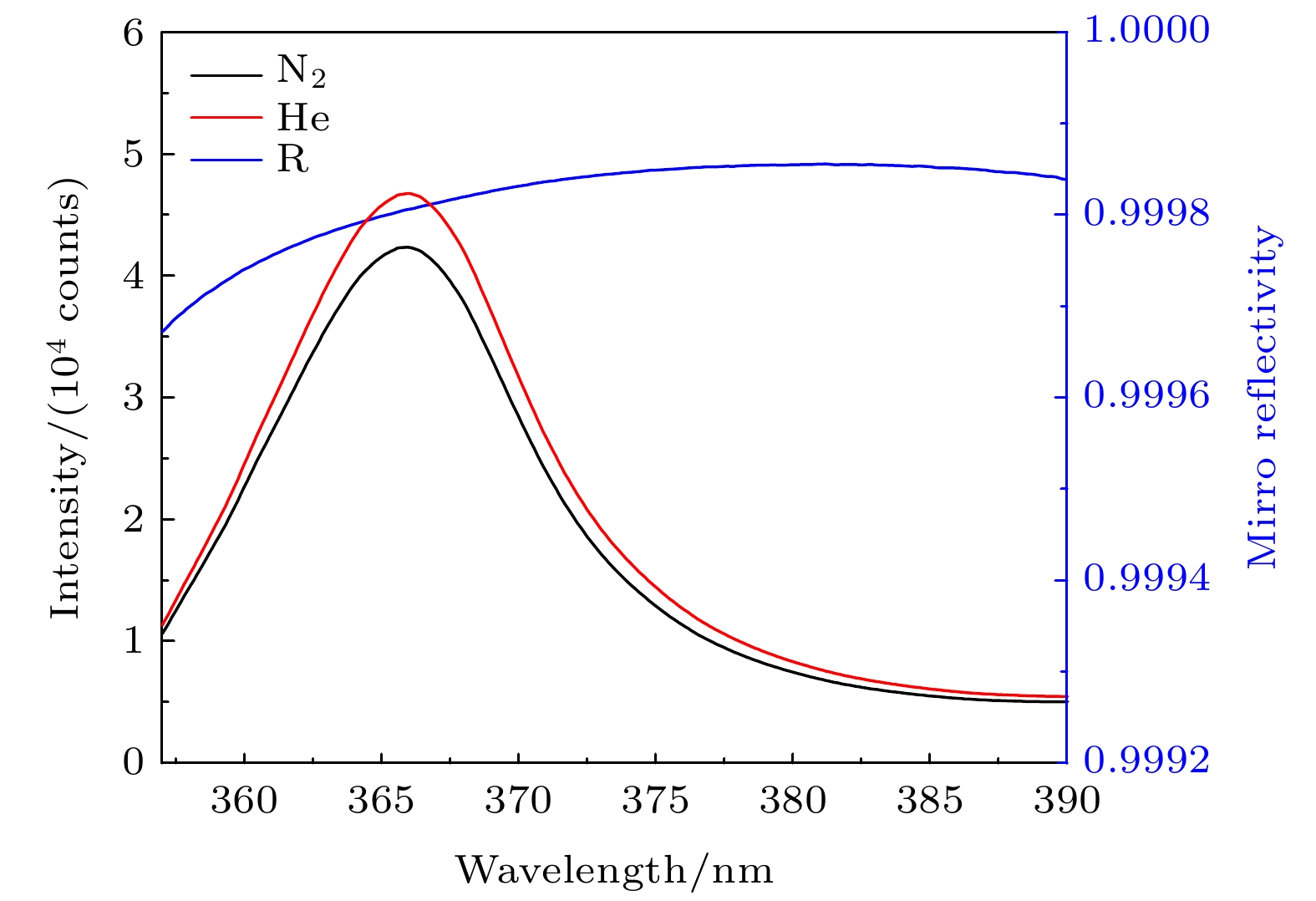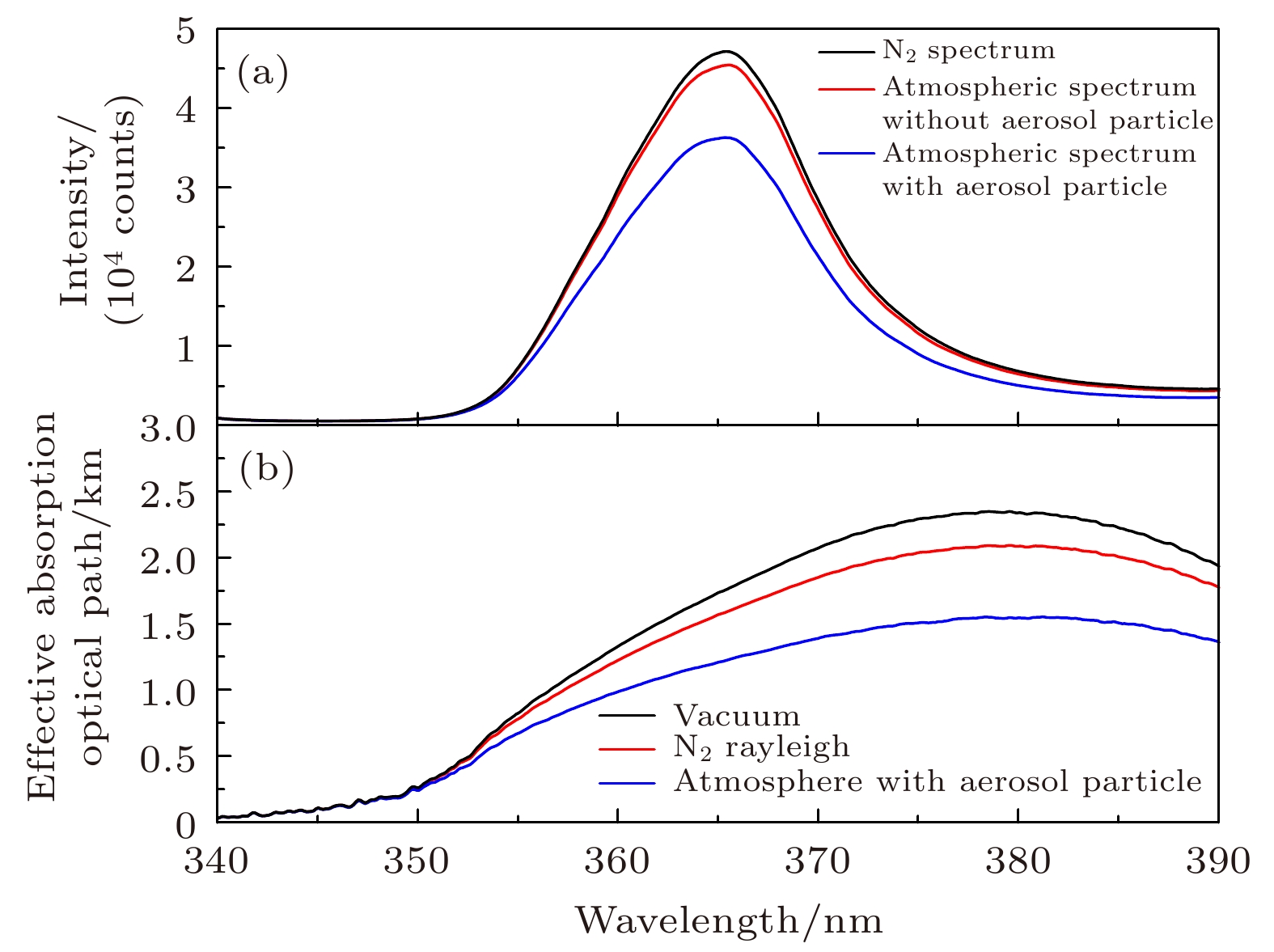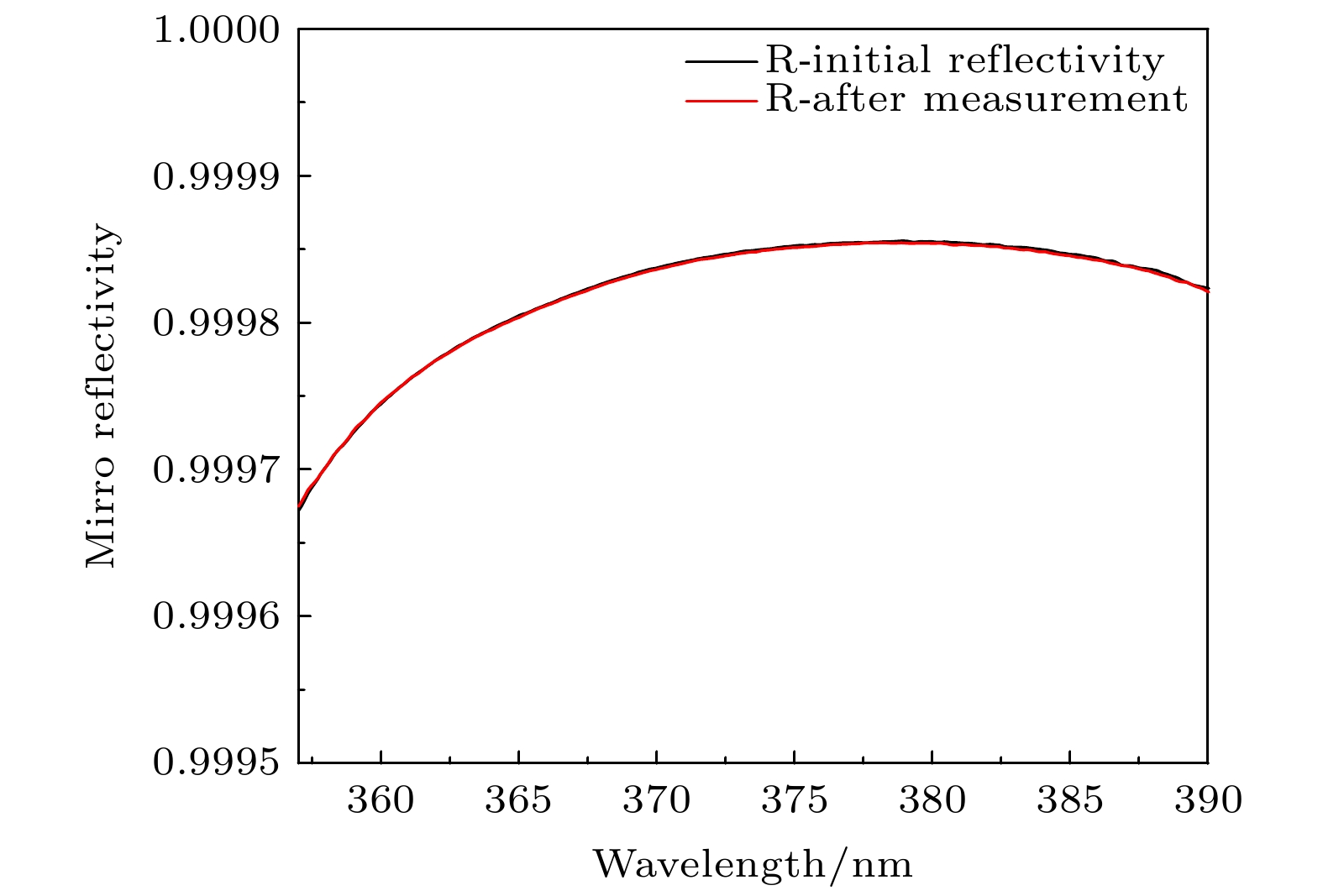-
Nitrous acid (HONO), as an important precursor of hydroxyl (OH) radical, has a low concentration, short lifetime, easy loss and high reactivity in the atmosphere. Thus, the high sensitivity detection of atmospheric HONO is a challenge. In this paper, we report an open-path broadband cavity enhanced absorption spectroscopy (OP-BBCEAS) system based on the iterative algorithm for simultaneous measurement of atmospheric HONO and NO2. In the conventional BBCEAS system, a pump is used to drive the ambient air into the optical cavity through the filter membrane for measurement, which can reduce the influence of aerosol particle extinction. However, the influence of wall loss and secondary formation caused by the optical cavity and sampling should be considered for reactive component measurements. The OP-BBCEAS with open-path configuration is adopted in this paper to avoid being influenced by wall effect. The effective absorption optical path is calculated by the iterative retrieval algorithm through multiple iterations, and the absorption of HONO and NO2 are then quantified by the spectral fitting method of differential optical absorption spectroscopy, which removes the broadband change influence of the Mie scattering extinction by aerosol particles and the light intensity fluctuation. The atmospheric HONO and NO2 with light (PM2.5 < 75 μg/m3) and moderate (PM2.5 > 75 μg/m3) aerosol loading are measured by the OP-BBCEAS system based on iterative algorithm, and compared with the counterparts by the conventional close-path BBCEAS system. The concentrations of HONO and NO2 measured by the two BBCEAS systems are in good agreement (R2 > 0.99) for different PM2.5 concentration levels, and the measurement differences of HONO and NO2 concentrations (HONO ≤ 4.0%, NO2 ≤ 6.5%) are less than the systematic measurement errors (HONO: 8.1%, NO2: 7.5%), which verifies the feasibility of iterative algorithm applied to OP-BBCEAS system for atmospheric measurement.
-
Keywords:
- broadband cavity enhanced absorption spectroscopy /
- open-path /
- iterative algorithm /
- differential optical absorption spectroscopy
[1] Elshorbany Y F, Kurtenbach R, Wiesen P, Lissi E, Rubio M, Villena G, Gramsch E, Rickard A R, Pilling M J, Kleffmann J 2009 Atmos. Chem. Phys. 9 2257
 Google Scholar
Google Scholar
[2] Kleffmann J 2007 Chemphyschem 8 1137
 Google Scholar
Google Scholar
[3] Perner D, Platt U 1979 Geophys. Res. Lett. 6 917
 Google Scholar
Google Scholar
[4] Legrand M, Preunkert S, Frey M, Bartels-Rausch T, Jourdain B 2014 Atmos. Chem. Phys. 14 9963
 Google Scholar
Google Scholar
[5] Cui X, Yu R, Chen W, Zhang Z, Pang T, Sun P, Xia H, Wu B, Dong F 2019 J. Lightwave Technol. 37 2784
 Google Scholar
Google Scholar
[6] Wang L, Zhang J 2000 Environ. Sci. Technol. 34 4221
 Google Scholar
Google Scholar
[7] Fiedler S E, Hese A, Ruth A A 2003 Chem. Phys. Lett. 371 284
 Google Scholar
Google Scholar
[8] Gherman T, Venables D S, Vaughan S, Orphal J, Ruth A A 2008 Environ. Sci. Technol. 42 890
 Google Scholar
Google Scholar
[9] Wu T, Zha Q, Chen W, Xu Z, Wang T, He X 2014 Atmos. Environ. 95 544
 Google Scholar
Google Scholar
[10] Min K E, Washenfelder R A, Dubé W P, Langford A O, Edwards P M, Zarzana K J, Stutz J, Lu K, Rohrer F, Zhang Y, Brown S S 2016 Atmos. Meas. Tech. 9 423
 Google Scholar
Google Scholar
[11] Duan J, Qin M, Ouyang B, et al. 2018 Atmos. Meas. Tech. 11 4531
 Google Scholar
Google Scholar
[12] Hoch D J, Buxmann J, Sihler H, Pöhler D, Zetzsch C, Platt U 2014 Atmos. Meas. Tech. 7 199
 Google Scholar
Google Scholar
[13] Johansson O, Mutelle H, Alexander E P, et al. 2014 Appl. Phys. B-Lasers O. 114 421
 Google Scholar
Google Scholar
[14] Liang S, Qin M, Xie P, et al. 2019 Atmos. Meas. Tech. 12 2499
 Google Scholar
Google Scholar
[15] Wang H, Chen J, Lu K 2017 Atmos. Meas. Tech. 10 1465
 Google Scholar
Google Scholar
[16] Grilli R, Mejean G, Kassi S, Ventrillard I, Abd-Alrahman C, Romanini D 2012 Environ. Sci. Technol. 46 10704
 Google Scholar
Google Scholar
[17] Dorn H P, Apodaca R L, Ball S M, et al. 2013 Atmos. Meas. Tech. 6 1111
 Google Scholar
Google Scholar
[18] Venables D S, Gherman T, Orphal J, Wenger J C, Ruth A A 2006 Environ. Sci. Technol. 40 6758
 Google Scholar
Google Scholar
[19] Chen J, Wenger J C, Venables D S 2011 J. Phys. Chem. A 115 12235
 Google Scholar
Google Scholar
[20] Varma R M, Venables D S, Ruth A A, Heitmann U, Schlosser E, Dixneuf S 2009 Appl. Opt. 48 159
 Google Scholar
Google Scholar
[21] Wu T, Chen W, Fertein E, Cazier F, Dewaele D, Gao X 2012 Appl. Phys. B-Lasers O. 106 501
 Google Scholar
Google Scholar
[22] Suhail K, George M, Chandran S, Varma R, Venables D S, Wang M, Chen J 2019 Spectrochim. Acta A 208 24
 Google Scholar
Google Scholar
[23] Horbanski M, Pöhler D, Lampel J, Platt U 2019 Atmos. Meas. Tech. 12 3365
 Google Scholar
Google Scholar
[24] Tang K, Qin M, Fang W, et al. 2020 Atmos. Meas. Tech. 13 6487
 Google Scholar
Google Scholar
[25] Stutz J, Kim E S, Platt U, Bruno P, Perrino C, Febo A 2000 J. Geophys. Res. Atmos. 105 14585
 Google Scholar
Google Scholar
[26] Voigt S, Orphal J, Burrows J P 2002 J. Photoch. Photobio. A-Chem. 149 1
 Google Scholar
Google Scholar
[27] Greenblatt G D, Orlando J J, Burkholder J B, Ravishankara A R 1990 J. Geophys. Res. 95 18577
 Google Scholar
Google Scholar
[28] Moosmüller H, Varma R, Arnott W P 2005 Aerosol Sci. Tech. 39 30
 Google Scholar
Google Scholar
[29] Platt U, Meinen J, Pöhler D, Leisner T 2009 Atmos. Meas. Tech. 2 713
 Google Scholar
Google Scholar
-
图 3 环境空气中气溶胶颗粒Mie散射对透射光谱强度和有效吸收光程的影响 (a)气溶胶颗粒Mie散射对透射光谱强度的影响; (b)气溶胶颗粒Mie散射对有效吸收光程的影响
Figure 3. Influence of Mie scattering of aerosol particles in ambient air on transmission spectral intensity and effective absorption optical path: (a) Influence of Mie scattering of aerosol particles on transmission spectral intensity; (b) influence of Mie scattering of aerosol particles on effective absorption optical path.
图 4 基于迭代反演的OP-BBCEAS算法和常规BBCEAS反演算法存在气溶胶消光影响时的大气HONO和NO2反演实例 (a)基于迭代反演的OP-BBCEAS算法存在气溶胶消光影响时的光谱拟合结果, 拟合残差的标准偏差为1.75 × 10–4; (b)常规BBCEAS反演算法存在气溶胶消光影响时的光谱拟合结果, 拟合残差的标准偏差为7.10 × 10–9 cm–1
Figure 4. Examples of HONO and NO2 retrieval of iterative retrieval algorithm and conventional retrieval algorithm with the influence of aerosol extinction: (a) Spectral fitting results of iterative retrieval algorithm with the influence aerosol extinction, the standard deviation of fit residual is 1.75 ×10–4; (b) spectral fitting results of conventional retrieval algorithm with the influence aerosol extinction, the standard deviation of fit residual is 7.10 × 10–9 cm–1.
图 6 基于迭代算法的 OP-BBCEAS系统和常规封闭腔BBCEAS系统测量不同PM2.5浓度(小时均值)下HONO和NO2浓度时间序列, 红色点线为OP-BBCEAS系统测量结果, 黑色点线为封闭腔BBCEAS系统测量结果
Figure 6. Time series of HONO and NO2 concentrations measured by OP-BBCEAS system based on iterative algorithm and conventional close-path BBCEAS system at different hourly average PM2.5 concentrations. The red dotted line is the measurements of open-path BBCEAS system, and the black dotted line is the measurements of close-path BBCEAS system.
图 7 基于迭代算法的OP-BBCEAS系统和常规封闭腔BBCEAS系统在不同PM2.5浓度下测量HONO和NO2浓度的相关性 (a)轻度(PM2.5<75 μg/m3)和中度(PM2.5>75 μg/m3)气溶胶污染状况下两台BBCEAS系统测量HONO浓度的相关性; (b)轻度(PM2.5<75 μg/m3)和中度(PM2.5>75 μg/m3)气溶胶污染状况下两台BBCEAS系统测量NO2浓度的相关性
Figure 7. Correlation of HONO and NO2 concentrations measured by OP-BBCEAS system based on iterative algorithm and conventional close-path BBCEAS system at different PM2.5 concentrations: (a) The correlation between HONO concentration measured by two BBCEAS instruments in light (PM2.5<75 μg/m3) and moderate (PM2.5>75 μg/m3) aerosol loading; (b) the correlation between NO2 measured by two BBCEAS instruments in light (PM2.5<75 μg/m3) and moderate (PM2.5>75 μg/m3) aerosol loading.
-
[1] Elshorbany Y F, Kurtenbach R, Wiesen P, Lissi E, Rubio M, Villena G, Gramsch E, Rickard A R, Pilling M J, Kleffmann J 2009 Atmos. Chem. Phys. 9 2257
 Google Scholar
Google Scholar
[2] Kleffmann J 2007 Chemphyschem 8 1137
 Google Scholar
Google Scholar
[3] Perner D, Platt U 1979 Geophys. Res. Lett. 6 917
 Google Scholar
Google Scholar
[4] Legrand M, Preunkert S, Frey M, Bartels-Rausch T, Jourdain B 2014 Atmos. Chem. Phys. 14 9963
 Google Scholar
Google Scholar
[5] Cui X, Yu R, Chen W, Zhang Z, Pang T, Sun P, Xia H, Wu B, Dong F 2019 J. Lightwave Technol. 37 2784
 Google Scholar
Google Scholar
[6] Wang L, Zhang J 2000 Environ. Sci. Technol. 34 4221
 Google Scholar
Google Scholar
[7] Fiedler S E, Hese A, Ruth A A 2003 Chem. Phys. Lett. 371 284
 Google Scholar
Google Scholar
[8] Gherman T, Venables D S, Vaughan S, Orphal J, Ruth A A 2008 Environ. Sci. Technol. 42 890
 Google Scholar
Google Scholar
[9] Wu T, Zha Q, Chen W, Xu Z, Wang T, He X 2014 Atmos. Environ. 95 544
 Google Scholar
Google Scholar
[10] Min K E, Washenfelder R A, Dubé W P, Langford A O, Edwards P M, Zarzana K J, Stutz J, Lu K, Rohrer F, Zhang Y, Brown S S 2016 Atmos. Meas. Tech. 9 423
 Google Scholar
Google Scholar
[11] Duan J, Qin M, Ouyang B, et al. 2018 Atmos. Meas. Tech. 11 4531
 Google Scholar
Google Scholar
[12] Hoch D J, Buxmann J, Sihler H, Pöhler D, Zetzsch C, Platt U 2014 Atmos. Meas. Tech. 7 199
 Google Scholar
Google Scholar
[13] Johansson O, Mutelle H, Alexander E P, et al. 2014 Appl. Phys. B-Lasers O. 114 421
 Google Scholar
Google Scholar
[14] Liang S, Qin M, Xie P, et al. 2019 Atmos. Meas. Tech. 12 2499
 Google Scholar
Google Scholar
[15] Wang H, Chen J, Lu K 2017 Atmos. Meas. Tech. 10 1465
 Google Scholar
Google Scholar
[16] Grilli R, Mejean G, Kassi S, Ventrillard I, Abd-Alrahman C, Romanini D 2012 Environ. Sci. Technol. 46 10704
 Google Scholar
Google Scholar
[17] Dorn H P, Apodaca R L, Ball S M, et al. 2013 Atmos. Meas. Tech. 6 1111
 Google Scholar
Google Scholar
[18] Venables D S, Gherman T, Orphal J, Wenger J C, Ruth A A 2006 Environ. Sci. Technol. 40 6758
 Google Scholar
Google Scholar
[19] Chen J, Wenger J C, Venables D S 2011 J. Phys. Chem. A 115 12235
 Google Scholar
Google Scholar
[20] Varma R M, Venables D S, Ruth A A, Heitmann U, Schlosser E, Dixneuf S 2009 Appl. Opt. 48 159
 Google Scholar
Google Scholar
[21] Wu T, Chen W, Fertein E, Cazier F, Dewaele D, Gao X 2012 Appl. Phys. B-Lasers O. 106 501
 Google Scholar
Google Scholar
[22] Suhail K, George M, Chandran S, Varma R, Venables D S, Wang M, Chen J 2019 Spectrochim. Acta A 208 24
 Google Scholar
Google Scholar
[23] Horbanski M, Pöhler D, Lampel J, Platt U 2019 Atmos. Meas. Tech. 12 3365
 Google Scholar
Google Scholar
[24] Tang K, Qin M, Fang W, et al. 2020 Atmos. Meas. Tech. 13 6487
 Google Scholar
Google Scholar
[25] Stutz J, Kim E S, Platt U, Bruno P, Perrino C, Febo A 2000 J. Geophys. Res. Atmos. 105 14585
 Google Scholar
Google Scholar
[26] Voigt S, Orphal J, Burrows J P 2002 J. Photoch. Photobio. A-Chem. 149 1
 Google Scholar
Google Scholar
[27] Greenblatt G D, Orlando J J, Burkholder J B, Ravishankara A R 1990 J. Geophys. Res. 95 18577
 Google Scholar
Google Scholar
[28] Moosmüller H, Varma R, Arnott W P 2005 Aerosol Sci. Tech. 39 30
 Google Scholar
Google Scholar
[29] Platt U, Meinen J, Pöhler D, Leisner T 2009 Atmos. Meas. Tech. 2 713
 Google Scholar
Google Scholar
Catalog
Metrics
- Abstract views: 6173
- PDF Downloads: 102
- Cited By: 0















 DownLoad:
DownLoad:






